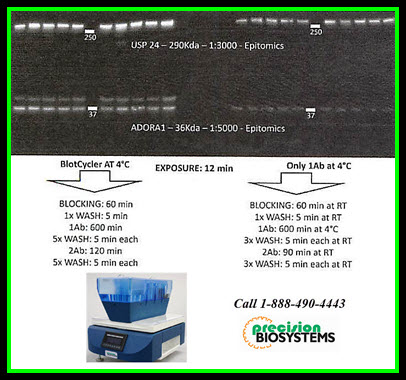New Western blot research applications featuring the BlotCycler™ are published continuously. Check back often for updates!
Analytical progresses of the World Anti-Doping Agency Olympic laboratories: a 2016 update from London to Rio
Athanasiado, I., Voss, S., Lyris, E., Aljaber, A., Alsayrafi, M., Georgakopoulos, C. Bioanalysis. (2016) 8(21): 2265-2279.
Abstract
The 2016 Olympic and Paralympic Games, the biggest event in human sports, was held in Rio de Janeiro with more than 10,500 athletes from 206 countries over the world competing for the highest of sports honors, an Olympic medal. With the hope that the Olympic ideal accompanies all aspects of the XXXI Olympiad, WADA accredited antidoping laboratories use the spearhead of analytical technology as a powerful tool in the fight against doping. This review summarizes the main analytical developments applied in antidoping testing methodology combined with the main amendments on the WADA regulations regarding analytical testing starting from the 2012 London Olympics until the 2016 Olympic Games in Rio de Janeiro.
Evaluation of AMGEN clone 9G8A anti-Epo antibody for application in doping control
Reichel, C., Benetka, W., Lorenc, B., Thevis, M. Drug Testing and Analysis (2016) 8: 11-12 1131-1137.
Abstract
The two mouse monoclonal anti-erythropoietin (EPO) antibodies clone AE7A5 (generated by using a 26 amino acid N-terminal EPO-peptide) and 9G8A (developed by immunizing mice with full length human EPO) are both directed against linear epitopes at the N-terminus of EPO. While AE7A5 has been commercially available for many years, 9G8A was made for Amgen’s internal research purposes. In the past, the commercial antibody was shown to cross-react with several proteins unrelated to EPO (e.g. E. coli thioredoxin reductase, zincα2glycoprotein, S. cerevisiae enolase, human neuron-specific enolase, and human non-neuronal enolase). However, it displayed high sensitivity for detecting recombinant EPO (rEPO) misuse by athletes on Western blots. We evaluated the potential use of clone 9G8A for doping control purposes. While 9G8A showed lower sensitivity than AE7A5 (ca 45% on isoelectric focusing (IEF)-polyacrylamide gel electrophoresis (PAGE), ca 40% on sodium dodecyl sulfate (SDS)- and sarcosyl (SAR)-PAGE), non-specific binding of the five proteins was not observed. The cross-reactivity of AE7A5 can be overcome by immunoaffinity purification of EPO before electrophoresis and Western blotting. Similar to AE7A5, clone 9G8A is also suited for Western double-blotting.
Antidoping programme and biological monitoring before and during the 2014 FIFA World Cup Brazil
Baume N, Jan N, Emery C, et al. British Journal of Sports Medicine, (2015) 49:614-622.
Abstract
Background
The FIFA has implemented an important antidoping programme for the 2014 FIFA World Cup.
Aim
To perform the analyses before and during the World Cup with biological monitoring of blood and urine samples.
Methods
All qualified players from the 32 teams participating in the World Cup were tested out-of-competition. During the World Cup, 2–8 players per match were tested. Over 1000 samples were collected in total and analysed in the WADA accredited Laboratory of Lausanne.
Results
The quality of the analyses was at the required level as described in the WADA technical documents. The urinary steroid profiles of the players were stable and consistent with previously published papers on football players. During the competition, amphetamine was detected in a sample collected on a player who had a therapeutic use exemption for attention deficit hyperactivity disorder. The blood passport data showed no significant difference in haemoglobin values between out-of-competition and postmatch samples.
Conclusions
Logistical issues linked to biological samples collection, and the overseas shipment during the World Cup did not impair the quality of the analyses, especially when used as the biological passport of football players.
Optimizing SAR-PAGE
Reihlen, P., Blobel, M., et al. Drug Testing And Analysis, (2015) 7: 1014–1016. doi: 10.1002/dta.1915.
Abstract
Due to its endurance enhancing effects erythropoetin (EPO) abuse in sport has a long tradition and is a well-documented phenomenon. Direct testing for EPO misuse in anti-doping control samples is performed via electrophoretic methods in combination with immunoblotting procedures. In 2013, the World Anti-Doping Agency (WADA) implemented an additional electrophoretic method named sarcosyl polyacrylamide gel electrophoresis (SAR-PAGE). The method relies on separation by molecular weight, similar to the sell-established sodium dodecyl sulfate – PAGE (SDS-PAGE) and solved an issue of lacking sensitivity for Mircera®, a PEGylated EPO analogue. … The challenge in routine anti-doping analysis lies in the identification of samples which contain eEPO and trace amounts of rEPO. These trace amounts are visible on an immunoblot as a diffuse or faint area above the eEPO band. EPO analysis is a multistep procedure, which is relatively expensive and time consuming – even more when analyzing large sample numbers. Detection of low rEPO concentrations in samples can only be successful when immunoblots show an excellent signal-to-noise ratio which can reliably be reproduced. An evaluation of the currently published procedures was undertaken to determine possible ways for optimization. As a result, the sample preparation procedure was revised and simplified to save both labour and material costs. Additionally, washing and incubation steps of the immunoblots were carried out by an automated western blot processor to optimize the workflow, reproducibility and quality of the results.
Improved detection of EPO in blood and urine based on novel Velum SAR precast horizontal gels optimized for routine analysis
Schwenke, D. (2015) Application Note DOC15012015 – I
Abstract:
To enhance the endurance performance the misuse of erythropoietin (EPO) is currently detected by isoelectric focusing (IEF) based on the profile of altered isoforms of EPO. Changes within the new WADA technical document allows for the detection of the different erythropoietins by using the Sarcosyl-PAGE, a modified SDS-PAGE. The Sarcosyl-PAGE which separates by difference in the molecular mass of EPO isoforms introduces a number of advantages: clear evidence between endogenous and the new modified exogenous EPO even when applied in smaller quantities; extended detection time of exogenous EPO, and a more simplified analysis. For EPO routine analysis a protocol based on a new type of Sarcosyl precast gels was established. For the evaluation of this improved detection method blood and urine samples of a micro-dose study were investigated.
Rapamycin Treatment of Healthy Pigs Subjected to Acute Myocardial Ischemia-Reperfusion Injury Attenuates Cardiac Functions and Increases Myocardial Necrosis
Lassaletta, Antonio D et al. The Annals of Thoracic Surgery (2014). 97.3 : 901–907.
Abstract
The Mechanistic Target of Rapamycin (mTOR) pathway is a major regulator of cell immunity and metabolism. mTOR is a well-known suppressor of tissue rejection in organ transplants, however, it has other non-immune functions including in the cardiovascular system, where it is a regulator of heart hypertrophy and locally, in coated vascular stents, inhibits vascular wall cell growth and hence neointimal formation/restenosis. Because the mTOR pathway plays major roles in normal cell growth, metabolism and survival, we hypothesized that inhibiting it with rapamycin, prior to an acute myocardial ischemia-reperfusion injury (IRI), would confer cardioprotection by virtue of slowing down cardiac function and metabolism.
EMRE is an essential component of the mitochondrial calcium uniporter complex.
Sancak, Y., Markhard, AL. et al. Science. (2013). 13;342(6164):1379-82.
Abstract
The mitochondrial uniporter is a highly selective calcium channel in the organelle’s inner membrane. Its molecular components include the EF-hand-containing calcium-binding proteins mitochondrial calcium uptake 1 (MICU1) and MICU2 and the pore-forming subunit mitochondrial calcium uniporter (MCU). We sought to achieve a full molecular characterization of the uniporter holocomplex (uniplex). Quantitative mass spectrometry of affinity-purified uniplex recovered MICU1 and MICU2, MCU and its paralog MCUb, and essential MCU regulator (EMRE), a previously uncharacterized protein. EMRE is a 10-kilodalton, metazoan-specific protein with a single transmembrane domain. In its absence, uniporter channel activity was lost despite intact MCU expression and oligomerization. EMRE was required for the interaction of MCU with MICU1 and MICU2. Hence, EMRE is essential for in vivo uniporter current and additionally bridges the calcium-sensing role of MICU1 and MICU2 with the calcium-conducting role of MCU.
When these researchers needed reliability and time-saving, reproducible results in their Western Blot Research Applications, they used the BlotCycler™ automated Western blot processor.
What’s in your lab?
Ready to get started automating your Western blot process?
Contact us at 1-888-490-4443




